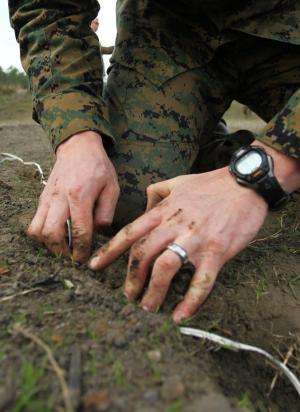Seeking tools for identifying hidden explosives at standoff

The threat to U.S. warfighters from improvised explosive devices (IEDs) is as varied as the makers of IEDs are resourceful in how they design and conceal the explosives. The Department of Defense has developed and deployed detection and counter-measures for many types of IEDs, but as the threat evolves, new defenses are required to keep warfighters safe. DARPA created the Methods of Explosives Detection at Standoff (MEDS) program to confront a specific class of IEDs: those deeply embedded in substances such as mud, meat or animal carcasses—i.e., opaque substances with high water content that cannot be safely and effectively probed with current technology.
Through MEDS, DARPA seeks proof-of-concept demonstrations of technologies and techniques that can rapidly and accurately detect the presence of bulk explosives in such substances using non-contact methods, meaning there can be no physical contact with the host substance. The technology would have to detect, but not necessarily image, explosives embedded at a depth of five centimeters or greater. To protect the health of the operators and people nearby, the tools developed may not use ionizing radiation, with the possible exception of x-ray backscatter. DARPA will evaluate proposed techniques on the anticipated tradeoff between image fidelity and radiation output.
Because of the constraints on using radiation, DARPA expects that new, interdisciplinary areas of research will be required to develop an effective solution. For that reason, universities, including the medical community, are encouraged to collaborate and propose innovative solutions along with commercial industry.
"MEDS technologies may require new engineering and physics. DARPA does not believe that incremental enhancements to existing imaging technologies will be adequate to meet the program objectives. However, the building blocks for a solution are in place, as we've seen in several recent scientific breakthroughs," said Dr. Judah Goldwasser, DARPA program manager for this effort.
Some potentially relevant research areas include ultra-wide-band thermo-acoustic imaging, phase-contrast methods, non-linear acoustics and mixed modality mechanisms.
"This program may represent a bit of a change for past DARPA university performers. We require proof-of-concept demonstrations of technologies and techniques, as opposed to just basic research," Goldwasser said. "Researchers' expertise, though, will be fundamental to a solution."
To allow for broad participation, proposers may propose appropriate surrogates for explosives to be used in testing; DARPA will specify common packaging substances at the program kickoff.
The anticipated period of performance for MEDS will not exceed 18 months, including a 12-month base period for research, development and demonstration of a capability, and a six-month option for follow-up reproduction and testing of successful capabilities at U.S. Government laboratories.
More information:
Provided by DARPA


















